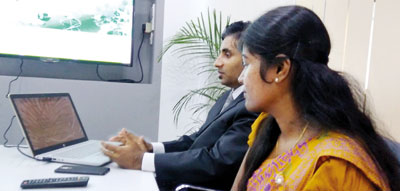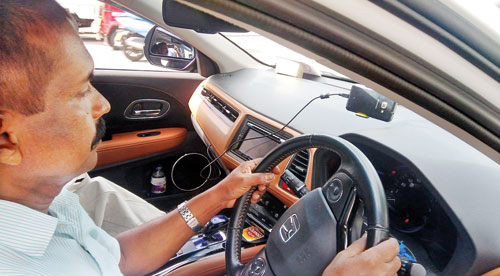New invention to detect drowsy drivers and avoid accidents
Road accidents occur due to many reasons such as negligent and rash driving, driving under the influence of liquor and drivers falling asleep. Consequent to research, it has been found that 12 per cent of accidents in Sri Lanka are caused due to drowsy and sleepy drivers. These numbers exceed the number of accidents that occur due to drunken drivers.

Ashok Kumara installing the telephone device with Sleep Alert software. Next to him is Ms Nishanthi Subramaniam, NSF Scientific Officer.
Around four years ago, a young engineering graduate from the Moratuwa University, Ashok Kumara and Ian Karunaratne, an MBA graduate from the Postgraduate Institute of Management (PIM), along with a group of friends went on a three -day trip to Nuwara Eliya.
While nearing Nuwara Eliya, Mr. Kumara felt uneasy when he looked out of the vehicle and saw a steep precipice. He thought that if the vehicle topples down the precipice the utter disaster would be chaotic, if by any chance the driver falls asleep.
The idea unnerved him and with his excellent engineering knowledge he was determined to formulate a device to sound an alarm before a driver falls asleep. It led to the birth of the invention ‘Anti-Sleep Driver Alert System ‘(ASDA) which is 90 per cent accurate. The IP protected device could be made available at an affordable price.
To achieve this end, the duo obtained a technological grant from the National Science Foundation (NSF) with the aim of marketing the product internationally. To find out the details of the ASDA, Ms. Nishanthi Subramaniam, Scientific Officer, NSF, accompanied the Business Times (BT) team to the company location, SleepAlert.me, GPD Building, No 57, Dharmapala Mawatha, Colombo 7.
The product makes drivers alert when they feel sleepy and it uses both eye blinking rate and driving pattern (steering pattern) for detecting drowsiness to sound an early warning.
Ms. Subramaniam said that NSF awarded the grant after carefully going through the usefulness in avoiding fatal road accidents, when drivers fell asleep. She said that before granting the award the NSF expert committees have very carefully gone through the project profile and on their assessment the decision was made to award the grant.
Elaborating on the potential socio economic impact, she indicated the benefit of this product in saving lives and saving millions of rupees of damage in Sri Lanka and in the world. The product with latest technology can compete in the global market and ultimately generate foreign currency to Sri Lanka.
At his second floor office, Mr. Kumara said that ASDA detects the drowsiness level by using both eye blinking rate and driving pattern thereby accuracy is increased.
He indicated that the device has inbuilt GPS (Global Positioning System) to detect speed and acceleration to adapt detection algorithms according to the situation.

The Sleep alert detection device on the dashboard
This is the only product developed based on the weather adaptive algorithms and uses a combination of light and sound for drowsiness alerting. Further, it has the customised alerts system while existing products have static alert system.
He pointed out that their ASDA is small in size when compared to existing products in the market. It is similar to the size of a mobile phone and is seven times cheaper than the existing ones in the market and gives high level of accuracy. He asserted that the online survey, which the inventors had carried out, revealed three key purchasing determinants (KPD) – effectiveness, convenience and affordability. Based on the survey it is found to be that ASDA is way above the existing products, he commented.
He said that his vision to invent such a device came because the probability of fatal accidents occurring increases when a driver falls asleep and the lives of others in the vehicle also rests on one individual.
He said that they have considered all the available options. Through his invention, he visualized the best way to alert the sleepy driver is the loud alarm system connected to the stereo sound system available inside the vehicle.
“If we can adequately alert the driver that would save lives. I needed some assistance and it has ideally come through NSF and to suit the requirements of the NSF I prepared a profile of the project and submitted it to the NSF for consideration. The financial grant so awarded by the NSF is in the range of Rs. 3.5 million,” he said.
The NSF is not providing any technical assistance, but most importantly they granted necessary finances to take the project off the ground, he stressed. He pointed out that the whole project involved very hard work.
He said that the alerting device resembles a mobile telephone, but it is not a telephone. He said “We use the mobile telephone but feed it into the software that has the feelers and the other technicalities inside the mobile telephone unit.”
He said “It is a telephone but the idea is if you think about the technical side, the economies of scale, it is difficult to find the exact hardware and if it is so the hardware would be very expensive. We can install commodity hardware if it is freely available and can modify them according to our requirements. Based on that we searched for the available hardware. From that we selected the mobile telephone device as the most common which we can easily modify.”
The device has to actually work in the night. The night vision part is also included as a component, he said. It could be operated during the day or night.
The device is fixed in front of the driver across the steering wheel that could directly identify the movement or the blinking eyes of the driver. It first identifies the head, then identifies the eyes and then identifies eye blinking. By using the blinking rate it identifies two things – one is whether the driver is sleeping or not and closing the eyes for more than one second.
The other one is the drowsiness. He said that drowsiness is the condition where one feels sleepy, but not sleeping. When a person is sleepy his blinking rate will be reduced. They then, he said, profile the blinking rate and from that the product identifies whether the driver is sleepy or not. It can detect whether the vehicle is moving or not and if not moving the alarm will not sound.
They applied for the NSF technological grant as individuals and are now in the process of forming a corporate body in the name and style of ‘Sleep Alert.me’. The duo maintains a lab with six people working at Wijerama, Nugegoda.


